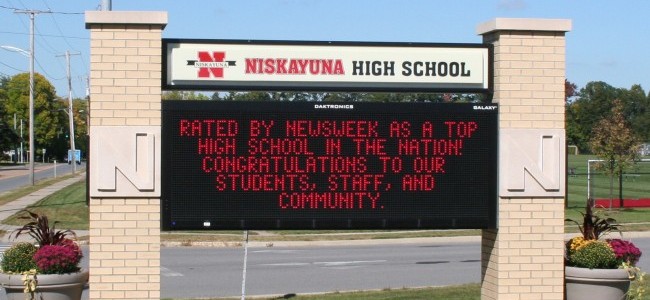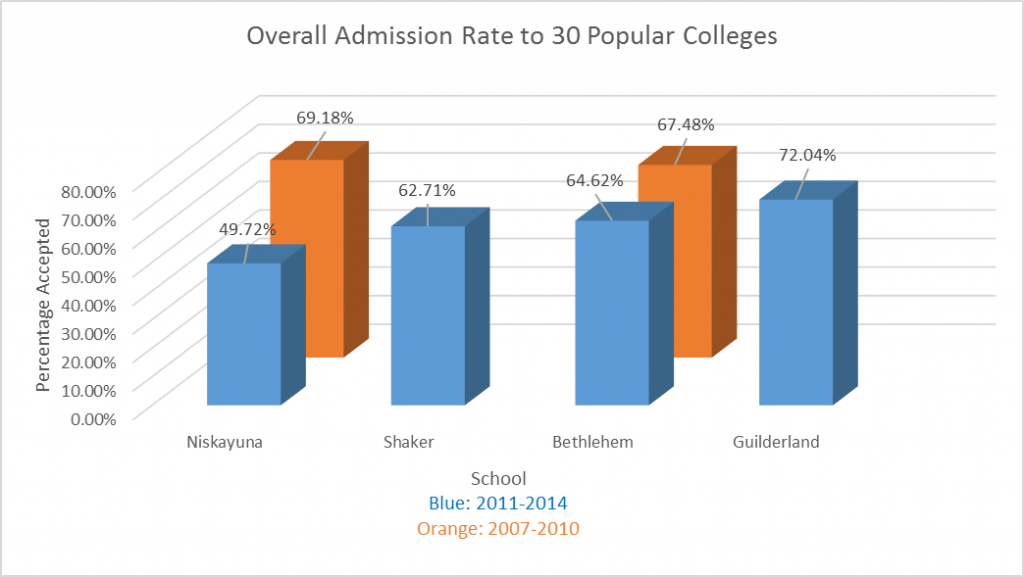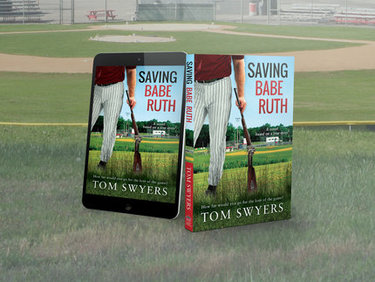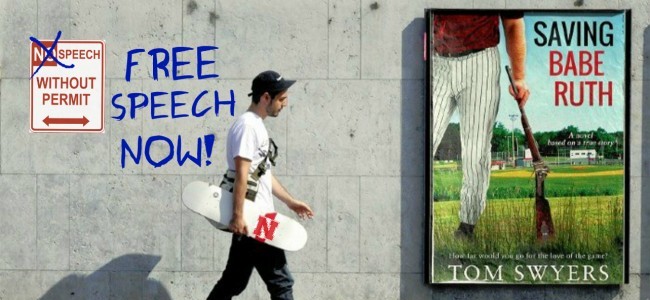Saving Babe Ruth is protected free speech.
I wrote the novel Saving Babe Ruth while residing in a nice Upstate New York town called Niskayuna. I graduated from its high school in the 1970s and so did my wife; my son graduated from there two years ago. All three of us grew up here and our families still live in town. I‘m proud to call it my home.
My high school principal’s name was Mr. Taormina. He knew my name back in high school, even knew about me. I liked to talk with him back then and so did my classmates. He always seemed available to listen and to guide us if we needed to talk. He made it part of his job.
I saw Mr. Taormina this past winter at the Schenectady Historical Society’s library. He didn’t remember my name but that’s understandable. A lot of time had passed. There had been a lot of students before me and a lot after me. He looked much like he did when he was principal. Yes, he looked older, but I thought I had caught up with him more than anything. There was still the same twinkle in his eye, his infectious smile, his love of people, his love of life. He joyously shared some of the details of his research project with my wife and my parents who were with me. I remember, thinking, there before me stood the essence of a good man.
Things have certainly changed at the high school since Mr. Taormina was principal. We live in different times. During this summer, I got a call from the current high school principal, John Rickert, also known as J.R. Rickert. He left me a voicemail on a Friday evening. He said he was looking for me, left his home number, and said he wanted to talk. Before I could return the call, he sent me an email the very next day, a Saturday.
In his email, Mr. Rickert expressed concern about my novel, Saving Babe Ruth, published in late June. Based on a true story, Saving Babe Ruth, on one level, is about one man’s fight to save a youth baseball league in his hometown. Many readers and reviewers have said that Saving Babe Ruth has appeal on a number of different levels, over and above what you might imagine from the title and knowing it has to do with kids’ baseball. I’ve been told by readers across the country that Indigo Valley—the town in Saving Babe Ruth—reminds them of their community.
Principal Rickert wrote in his email: “It has come to my attention that you may have created a character in your novel based on me. Is this correct? My attorneys are reviewing the book for accuracy of your portrayal of me.” Mr. Rickert went on to say that “the purpose of this message is to advise you that my team will be watching every interview, public statement and post” concerning Saving Babe Ruth.
Mr. Rickert is likely referring to his sports and entertainment “team” of employees and/or associates. You see, Mr. Rickert, in addition to being a full time principal at Niskayuna High School, is also a professional sports agent. He represents clients like ex-New York Giants David Diehl (now an NFL analyst for FOX) and Hakeem Nicks (now with the Indianapolis Colts) and ex-New York Jet and Cleveland Browns kick return sensation, Josh Cribbs. He has clients in professional football, basketball, baseball, and boxing. He says on his website that he has over one hundred sports and entertainment clients and he lays claim to being one of the most successful agents in the country today.
One would think that a school district might be interested in having one of the most successful principals in the country to oversee the high school, but I guess having a sports agent as a principal somehow became our definition of success somewhere along the way. Niskayuna Interim Superintendent John Yagielski (the last superintendent abruptly resigned in 2013) recently said about the goals of the school district going forward: “We need to establish unequivocally—and I can’t think of a stronger word because it needs to be unequivocal— that student learning is our focus.” Even though Mr. Yagielski is a highly regarded administrator, I think achieving this goal is quite a challenge when you have a professional sports agent at the helm of your high school.
Mr. Rickert’s email goes on: “[I]f we discover any ‘false light portrayal’ pursuant to New York statute, I reserve the right to pursue any and all legal remedies.”
Given that Mr. Rickert has been involved as a defendant in a number of previous lawsuits (one involving a breach of contract claim and bouncing checks with Auddie Attar, his former sports business partner), I suppose people around me are correct in saying that Mr. Rickert is threatening me, an alumnus of the school and a resident of the school district.
Mr. Rickert is on the defensive here in his email and I don’t hold him totally responsible for this state of affairs. In my opinion, if the Niskayuna Board of Education had enforced its Code of Ethics (Section 2160) over the past decade, he wouldn’t have written his email because he wouldn’t be allowed to do what he does now. I’m not sure why Mr. Rickert has been allowed to proliferate his sports business while he has been a principal. One would think it was a conflict of interest to do both. If it’s not, it should be. A principal should never be in the position of having to choose between the health, safety and welfare of the children he is charged with and the needs of such high profile clients like professional athletes.
Organizations pass and enforce conflict of interest policies precisely to avoid the situation Niskayuna finds itself in today. The school board should not be in the position of having to monitor J.R. Rickert’s actions as a sports agent on a daily basis, but that’s the position it has assumed over time. The board’s focus should solely be on the children in the school district.
Yes, I know it’s hard to imagine a sports agent who’s a full time high school principal if you’re from out of town. Saving Babe Ruth has been receiving very favorable reviews overall, but people have raised their eyebrows over Jerry Conway, the principal/sports agent character in the book. Readers and reviewers don’t believe such a character could exist. They need to come to my hometown.
One reader said in reviewing the book, “The principal totally boggled my mind. I was a teacher for a while and I cannot imagine a principal getting away with such actions and supposedly ‘off the radar’ of the community at that.”
Then there’s a respected reviewer of sports books, Lance Smith, who wrote in disbelief, “I mean, really, an agent representing a superstar NFL running back can double as a school principal?”
Finally, there’s Dennis Anderson. He’s a seasoned newspaper editor and serves on the Associated Press Media Editors board of directors. We had an email exchange after he read the book. At one point, I asked him what he thought of the sports agent/principal character. He replied:
I thought the principal character was a stretch but I got over it. I base that on my personal experiences with high school parents. My youngest of two sons just graduated from high school. It was our eighth straight year of having a son in high school. If there is anything more extreme than youth sports parents, it’s parents whose kids excel in academics. If they ever got wind of a principal moonlighting, well, guess what would happen. That’s my thought on that.
When I informed him that there is a high school principal who doubles as a sports agent, he said that this proves fact is stranger than fiction.
I traveled quite a bit this past summer talking about Saving Babe Ruth. When people ask me if there’s really a principal who is a sports agent too and I say there is one, they can’t believe their ears.
We are unusually quiet about this topic here in town and the local press doesn’t seem too engaged in the topic lately. I hear the mumbling from within our town; I hear the gasps of disbelief and laughter from those who live on the outside. But mum’s generally the word around here these days for something that started with one client and grew to over one hundred in the span of a decade. In a 2010 interview (subscription required) with Schenectady’s Daily Gazette newspaper, the district school superintendent then in charge admitted he had received anonymous letters concerning the the principal being a sports agent. Parents understand that their children must pass through the high school and speaking-up publicly might might have repercussions. In February of 2014, Niskayuna Schools held its “first community conversation” attended by seventy-five parents. School personnel and parents broke into small groups to talk about values and priorities. A thirty-one page document was produced noting all the comments of parents in the small groups.. The high school principal was never mentioned in any context.
Whatever concerns people may have about the principal being a sports agent might be mollified by press releases from the school district noting its high rankings in various publications. In June 2013, the Albany Business Review ranked Niskayuna as the No. 1 performing district in the Albany, New York area. The “Upstate Schools Report” published in October of 2013 by Buffalo Business First ranked Niskayuna 11th overall and No. 2 in the Albany area. These milestones were publicly celebrated by Niskayuna School District in its announcements, on its website, and through its social media accounts. On the Niskayuna High School Website, there is a menu item that invites the reader to “Meet Our Principal.” Click the link and you’ll learn all about the high school’s ranking accomplishments, but nothing about about Mr. Rickert. Over the years, the public relations effort has been effective in at least one way: parents seem less likely to think about the high school principal situation if they think all the high rankings are somehow taking care of their kids.
Five years ago, J.R. Rickert (sports agent) and John Rickert (principal) seemed like two different people. You could look up agent J.R. Rickert on the internet and or listen to him on the radio (he had his own Friday evening radio show during the football season on Fox Sports before moving to ESPN Radio) and you would be unaware that he was a principal of a high school. Likewise, you could look up John Rickert as principal and be unaware that he was a sports agent. He tried to keep his jobs separate in the eyes of the public. In an Albany Business Review 2009 article, J.R. Rickert said he hoped to grow his sports business to into a $1 billion dollar operation. The article never mentioned the fact that he is also the full time principal at Niskayuna High School, a job that currently pays $141,444 per year as noted on the website SeeThroughNY.
Then Carl Strock, former columnist for the Daily Gazette, started asking questions in a 2010 newspaper article (subscription required) about his dual roles. Strock asked Mr. Rickert how he could be both a principal and a sports agent. He said he never got a clear answer to this question, though Rickert said he tried to keep the two jobs separate.
In the fall of that year, J.R. Rickert appeared on a local sports radio talk show with host John Graney. J.R. Rickert obviously thought he was there to answer sports questions. But John Graney put him on the spot and began asking questions about how J.R. Rickert could do deals for football clients and effectively be a high school principal. Suddenly, J.R. Rickert said he was having problems with his telephone connection. Keeping the two jobs separate in the eyes of others had become a lost cause.
Then came a new approach. In a 2011 Success Magazine interview, John Rickert and J.R. Rickert became one and the same, a superior multitasker who could balance his life as a high school principal along with being one of the country’s top sports agents. He publicly embraced his two roles:
My life is extremely demanding, yet extremely rewarding. I love the balance of responsibilities that I deal with on a daily basis. The fact that I am involved in so many things guarantees that I will never have a boring day.
Perhaps his involvement in too many things played a role in Mr. Rickert’s fine and suspension as an NFL agent one day in 2013. I doubt the days leading up to this event were boring.
I recall that my principal, Mr. Taormina, had more than he could handle when he was in charge. I can’t imagine him ever having a boring day looking after us teens. We were a handful back then trying to make sense of our lives while looking forward to what lay ahead. I can’t imagine teens are any different in that one respect today.
I don’t think anyone in our town or in our area has publicly said that it’s not a great idea to have a principal who is also sports agent. If that’s the case, let me be the first then.
I should add that my opinion has nothing to do with Mr. Rickert as a person. A number of people have said that they have had pleasant conversations with him over the years. I’ve never spoken with him before so I don’t know him personally. I’m sure he has plenty of supporters and he has had some noteworthy accomplishments.
 Niskayuna School District has a stellar history. As noted, it’s been ranked highly over the years and has had a excellent reputation for decades. The teachers and staff do a wonderful job overall. Most recently In September of this year, Niskayuna High School was ranked 26th in the country by Newsweek as a high school doing the best job of preparing students for college. This accomplishment flashed on the illuminated entrance sign to the high school.
Niskayuna School District has a stellar history. As noted, it’s been ranked highly over the years and has had a excellent reputation for decades. The teachers and staff do a wonderful job overall. Most recently In September of this year, Niskayuna High School was ranked 26th in the country by Newsweek as a high school doing the best job of preparing students for college. This accomplishment flashed on the illuminated entrance sign to the high school.
Personally, I don’t believe the school district’s educational reputation with the college admissions recruiters is enhanced when they visit the high school every autumn and learn of our situation. And I don’t think last year’s fine and suspension of Mr. Rickert as an NFL agent does anything to enhance the school district’s educational reputation either. I would think that upholding this reputation of our high school would be part of the job of being principal. Niskayuna competes with 30,000 plus high schools across the country in placing its students. In merging the identities of J.R. Rickert and John Rickert in the eyes of the public, the school district’s reputation is now tied to J.R. Rickert’s reputation as a sports agent. I don’t see how this helps the high school compete.
Times have changed in Niskayuna in more ways than one. Even if Niskayuna does a wonderful job preparing children for success in college as suggested by the Newsweek study, if they’re not readily being admitted, then it really doesn’t matter as much how well they’ve been prepared. Despite its achievement, I believe Niskayuna is now lagging on the admissions front.
If I were Mr. Yagielski and Principal Rickert, I’d be concerned with a chart like this one:

The chart represents the combined admissions data to thirty popular colleges and universities across all of the four high schools studied. The charts were compiled with the data provided by the school districts themselves through their “Naviance” computer databases. The names of the colleges and universities are noted at the end of this article.
In the chart, Niskayuna is compared with three other comparable high schools in the Albany area that have ranked close to Niskayuna over the years in other studies. Two of these high schools are not ranked in the Newsweek national study (Guilderland and Shaker) and a third (Bethlehem) is at 398 in the rankings.
Note that during 2011-2014 (blue), Niskayuna has the lowest acceptance rate (49.72%) of the four high schools to the thirty of the most popular colleges and universities frequently applied to by students from these high schools. During 2007-2010 (orange), Niskayuna achieved an acceptance rate of 69.18% to these same colleges and universities. Over the past four years there’s been an overall drop of nearly 20% in the acceptance rate among students from Niskayuna to these institutions. Note that in Bethlehem (the only other school that has data going back to 2007), the admission rate has been fairly stable throughout from 2007-2014. If Niskayuna is ranked so highly, then its admission rate should equal or exceed Guilderland’s 72% rate today.
When the highest ranked high school has the lowest college acceptance rate, it’s time to start asking some questions. People can debate all they want about what seems to have caused a decline in college admissions at Niskayuna High School. What’s needed now is leadership to get the district out of the quagmire and to move the school district forward. Continuing to look the other way from the challenges is to perpetuate the problem. Threatening authors and district residents with lawsuits is ridiculous and does nothing to enhance the school district’s reputation in the eyes of anyone, including college admissions officials and potential applicants for the open job of superintendent. I don’t think the threat of litigation is a great idea if the goal here is to have a transparent and open school district that listens to the community as Mr. Yagielski has asserted a number of times over the past year.
Let me be clear on a few things. I have a First Amendment right to author a novel and I firmly stand behind Saving Babe Ruth. I also have the First Amendment right to express my views concerning the affairs of my hometown school district. So if Mr. Yagielski or anyone else wants to listen, much of what I have to say is found in Saving Babe Ruth. The novel has resonated in communities across the nation. I think it would resonate with people in my hometown and in the 518 area code as well.
I feel badly about what recent Niskayuna High School graduates may have experienced in planning for their futures. I’m concerned about what might happen to the children here going forward if we do not address our issues.
I will continue to speak about children’s rights on the playing field and in the classroom in the course of exercising my First Amendment rights. An emphasis on sports professionalism is seeping into community based youth sports and into our schools and this is hurting children and families everywhere. As a nation, we need to openly discuss the issue. This tragedy is what compelled me to write Saving Babe Ruth.
I’ve worked with many at-risk kids in this town through my volunteer work with our youth baseball league over the past fifteen years. I have dealt with some life threatening mental health issues in children that you wouldn’t imagine finding in a youth sports league. I don’t think our town is unique in having to face mental health issues on a daily basis. I know that children and teens in particular need our full attention to save as many of them as possible. On one level, that’s a theme in Saving Babe Ruth.
In the end, Saving Babe Ruth will triumph as free speech. I don’t think it matters much about what I alone think about our situation here. I’m one voice. The opinions that will ultimately matter are those of the collective body of students, alumni, parents, teachers and residents of the town and school district. It’s time to confront the reality that’s been created.
I’m hopeful that this town—my hometown—and its schools will eventually be stronger and better for doing so. I’m hopeful that Saving Babe Ruth will prompt thought and discussion across this country about the many challenges faced by children today in youth sports and in the classroom. The issues confronted by Saving Babe Ruth are universal and apply to families and communities everywhere and it’s time to discuss them openly without threats of retaliation.
(Colleges and universities studied: Boston College, Boston University, Clarkson, College of Saint Rose, Cornell University, Fordham University, Hartwick College, Hudson Valley Community College, Ithaca College, Le Moyne College, Marist College, New York University, Northeastern, Rochester Institute of Technology, Rensselaer Polytechnic Insitutue, Schenectady Community College, Siena College, SUNY Albany, SUNY Binghamton, SUNY Buffalo, SUNY Cortland, SUNY Geneseo, SUNY Oneonta, SUNY Oswego, SUNY Plattsburgh, SUNY Stony Brook. Syracuse, Union College, University of Rochester, University of Vermont).
 Baseball is dying; only one man can save it. Based on a true story, Saving Babe Ruth is about a father willing to risk it all to save baseball for his son and the sandlot kids in town. It’s also about a family trying to stay together through it all. (Hillcrest House Publishing, 2014, ISBN 978-1941440001, $16.95, TomSwyers.com.) Saving Babe Ruth is available in paperback at Amazon and in e-book format at most retail outlets.
Baseball is dying; only one man can save it. Based on a true story, Saving Babe Ruth is about a father willing to risk it all to save baseball for his son and the sandlot kids in town. It’s also about a family trying to stay together through it all. (Hillcrest House Publishing, 2014, ISBN 978-1941440001, $16.95, TomSwyers.com.) Saving Babe Ruth is available in paperback at Amazon and in e-book format at most retail outlets.

